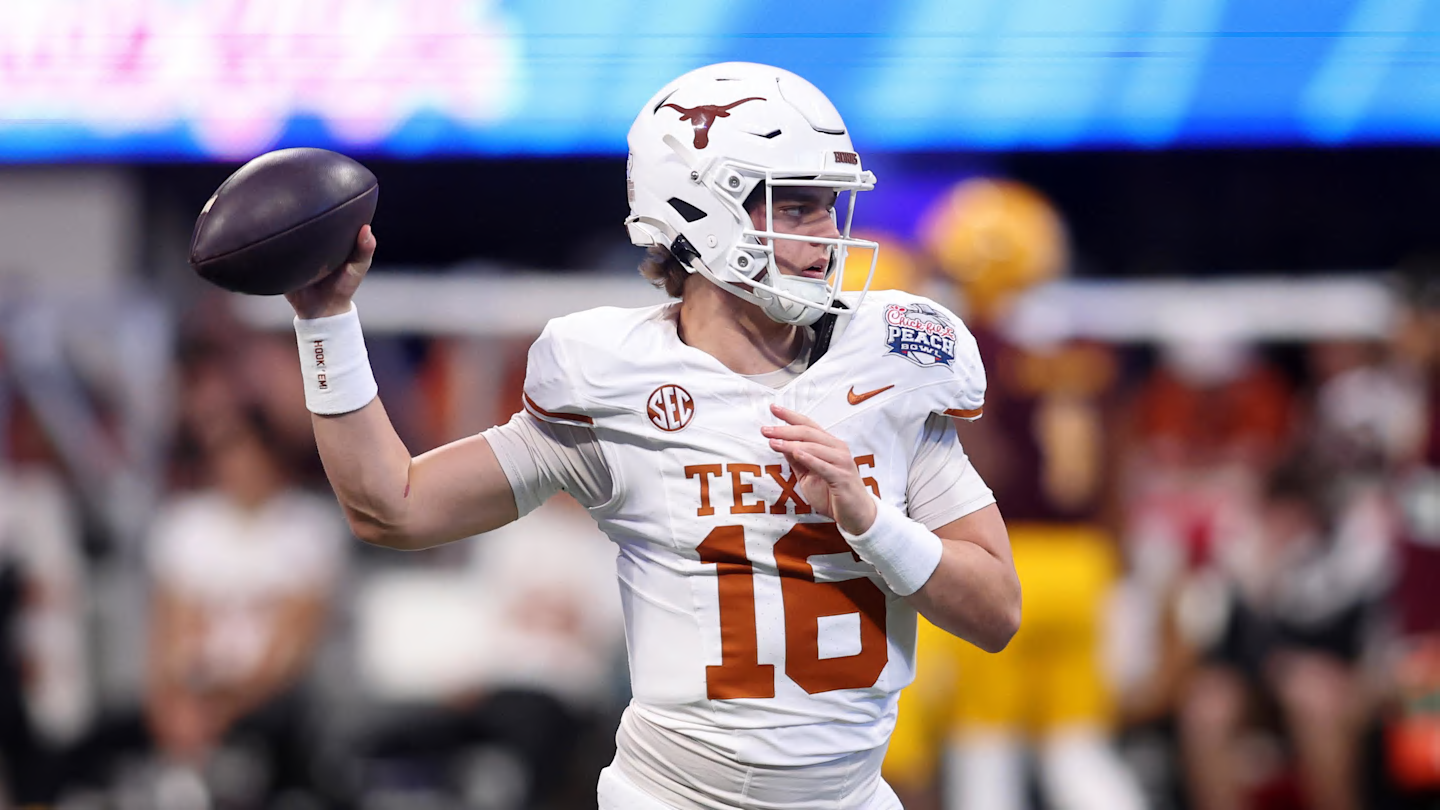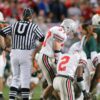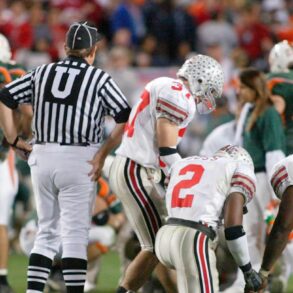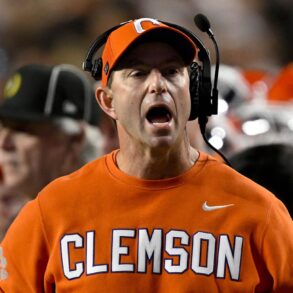
College football crossed the offseason Rubicon last weekend as we’re now closer to kickoff in Week 0 than we are removed from the national title game. As we hit the downslope barreling toward the upcoming 2025 season—and with most of the transfer portal activity quieted down—it’s time to check in with the major conferences to see just how they’re shaping up coming out of the spring.
You can find the ACC edition here, the Big 12 here and the Big Ten here. Next up? The SEC.
It just means more in the SEC, but for the past two seasons at the end of January, the conference where college football is king has been sitting out of the national game. Last season’s inaugural 12-team College Football Playoff underscored some of the league’s (admittedly rare) struggles on the grand stage, with three schools getting left out of the field for the likes of the Indiana Hoosiers of all programs and the newbie Texas Longhorns being responsible for all of the SEC’s wins in the tournament.
While it’s become quite apparent the transfer portal and NIL have siphoned off some of the overpowering success the SEC has typically had on the gridiron, those around the league certainly aren’t sitting back and watching. If anything, this offseason has been one featuring plenty of staff and roster changes aimed at not only surviving a gauntlet of eight games, but to help get the conference back on top of the football world. It won’t be an easy task making sure all those resources don’t go to waste for another season, but this being the SEC, it has an added air of desperation after the longest trophy drought in a decade.
Let the Arch Manning era begin. For all the outside hype the young quarterback’s last name is set to bring to the 40 Acres in 2025, the coaching staff remains confident that not only can young Arch handle it all, but he’s got the team to do something big in his first season as a starter. The roster has lost a lot (double-digit draft picks the past two years), but the Longhorns smartly shopped in the portal to plug a few holes and still have several stacked classes of high-end high school talent ready to break out. The defense can remain something to lean on as a group of dynamic skill position players get on the same page, but this remains the team to beat in the SEC until further notice.
Perhaps the only obstacle might be a schedule that features road trips at the Ohio State Buckeyes, Florida Gators and between the hedges in a conference title game rematch with the Georgia Bulldogs. That’s balanced out by a modest home slate in Austin that could be the most manageable in the entire league.
Dark horses: Alabama Crimson Tide, Georgia Bulldogs
Aiming high: Auburn Tigers, Florida Gators, LSU Tigers, Missouri Tigers, Ole Miss Rebels, South Carolina Gamecocks, Tennessee Volunteers, Texas A&M Aggies
Battling for a bowl: Arkansas Razorbacks, Kentucky Wildcats, Oklahoma Sooners, Vanderbilt Commodores
Building for next year: Mississippi State Bulldogs
There’s been enough changes in Tuscaloosa, Ala., and Athens, Ga., this offseason to hold back regular SEC contenders Alabama and Georgia from being the favorites to win it all in Atlanta in December. For Kirby Smart’s program, that starts with a new-ish quarterback in Gunner Stockton, whose sample size has been limited, a revamped offensive line and a slew of new defensive starters. Just about every coach in America would still take that situation given what Smart has built up, but there could be a few growing pains before the team hits its stride in SEC play. As for the Tide, there’s still some skepticism in the South over Kalen DeBoer given some of the team’s inexplicable losses last season. However, this is still a stacked two-deep roster that could make it a threat to get back to the playoff if Bama can settle on a quarterback.
Elsewhere around the SEC, there is once again a deep crop of potential threats, but therein lies the problem: Somebody has to lose and only a handful of such programs can win enough to remain near the top of the standings come late November. Florida, South Carolina, LSU and, to a lesser extent, Texas A&M all believe they have an elite signal-caller who may be able to cover up some flaws while others like Auburn, Ole Miss and Tennessee believe they’ve won enough transfer portal battles to do more than get seven or eight wins.
Then there’s the remaining five teams, who could help threaten to get the SEC more than the 12 bowl-eligible teams it had a year ago … but could also just as easily find themselves in a late fight to get to six wins. That’s life in a very unforgiving league.
It rankled a few folks in the spring around the South that jokes were being made about the SEC becoming a basketball league. While such quips were made a bit in jest—and they had somewhat of a point given historical success was capped off by a Florida title—it underscored that the SEC hasn’t been operating at the level it used to on the gridiron. Some of that can be prescribed to added depth with the additions of Texas and Oklahoma, but you only had to tune in on a random Saturday to see that the likes of Georgia, Alabama, LSU and others simply weren’t as good as some of their recent standard-bearing squads.
The Dawgs lost as many games as they had in the prior four seasons combined, and losing the greatest coach of all time at Alabama was underscored by inexplicable losses to Vandy and Oklahoma. Some teams (such as Ole Miss) dropped the ball down the stretch, and injuries caught up with others (like South Carolina) at times. What’s worse, the perception of the SEC slipping (especially in relation to the Big Ten) has to wound the egos of those around the league almost as much as some disappointing results on the field.
Yet the coming campaign can offer up a chance for a turnaround. Texas and Georgia figure to be pegged as early top-five squads and LSU is trending in the right direction given how active the program was in the portal. Alabama and South Carolina could be not too far behind. Plus, there are some marquee nonconference games early on in which the SEC can lay the groundwork for a reset in the narrative.
Will that be enough to get back in the national title picture and be reestablished as a perennial favorite? There is a lot of optimism the recent dip in form will be subsiding and those S-E-C chants will ring out as a source of pride and not as a bit of mocking from a few opposing fan bases.
The SEC has produced multiple Heisman Trophy–winning quarterbacks the past few years, but the drop-off at the position last season was noticeable, as no starter completed more than 70% of their passes or threw for over 30 touchdowns (four different signal-callers also threw for double-digit interceptions). Between injuries and/or ineffective play, the caliber of player at the most important position on the field contributed to a significant QB derby of departures, replacements and rising hope this offseason that things could be different in 2025.
While Manning naturally gets most of the attention when it comes to such optimism, NFL scouts and fans alike are hopeful that he won’t be the only one lighting it up in a pass-happy system this fall. Garrett Nussmeier, LaNorris Sellers and DJ Lagway all have the ability to get into the Heisman Trophy mix, and Diego Pavia returns for one last ride at Vandy as the league’s most electric player with the ball in his hands. Schools like Oklahoma and Auburn both upgraded at the position. There’s hope Stockton can play more like he did for Georgia in the conference title game than he did against the Notre Dame Fighting Irish in the Sugar Bowl.
If the conference wants to get back to winning at the highest level again, it’s imperative that SEC quarterbacks lead the charge instead of holding back their teams.
Transfers: Washington State Cougars QB John Mateer (Oklahoma), Florida State Seminoles edge Patrick Payton (LSU), Georgia Tech Yellow Jackets WR Eric Singleton Jr. (Auburn), USC Trojans WR Zachariah Branch (Georgia), Nebraska edge Princewill Umanmielen (Ole Miss)
Freshmen: Alabama QB Keelon Russell, Georgia DL Elijah Griffin, Texas DB Jonah Williams, Oklahoma OT Michael Fasusi, Tennessee OT David Sanders Jr.
Draft: LSU OT Will Campbell, Georgia edge Mykel Williams, Alabama OG Tyler Booker, Georgia LB Jalon Walker, Ole Miss DT Walter Nolen
Transfers: Tennessee QB Nico Iamaleava (UCLA Bruins), Georgia QB Carson Beck (Miami Hurricanes), Kentucky DL Keeshawn Silver (USC Trojans), Missouri DL Williams Nwaneri (Nebraska Cornhuskers), Alabama RB Justice Haynes (Michigan Wolverines)
It’s the SEC, so in some respects, every coach is on the hot seat. That said, there are a few situations that are quite warm and have the potential to reshape the coaching market in a significant fashion.
There’s little denying that Arkansas’s Sam Pittman is likely coaching for his job this season, with that nine-win campaign in 2021 a distant memory in Fayetteville, Ark., and no more than seven wins in any of his four other seasons in charge. His buyout is complicated based on how many wins the Razorbacks can muster, but it is unlikely enough to prevent a change if things go south this year either way (interim head coach Bobby Petrino anybody?). A brutal September stretch at Ole Miss, at the Memphis Tigers and home against Notre Dame will likely prove to be a defining one for Pittman.
Aside from the Hogs, Oklahoma’s Brent Venables and Florida’s Billy Napier each have a tricky situation to navigate and would be well served to win and win big. The Gators coach is just .500 entering Year 4 but at least has some momentum on his side after a four-game winning streak to close 2024 out included upsets of LSU and Ole Miss. He has a star quarterback to build around, has some staff continuity and brings back a much improved roster compared to his first years on campus. The issue, as always for Florida, is that the schedule will do Napier no favors and the range of outcomes for the Gators can be anywhere from 9–3 for the optimists to 5–7 (or worse) if things break the wrong way. The school would prefer to have the decision taken out of its hands, but a new incoming president and an athletic director on the hot seat make for a messy situation in Gainesville, Fla.
Venables, who has sandwiched twin 6–7 seasons around a 10–3 mark in 2023, also faces plenty of pressure going into the fall and simply cannot have the Sooners looking so outclassed when they take the field against some of the league’s other big names. The head coach is taking charge of the defense and has completely revamped the offensive staff to show his sense of urgency, while also bringing in a slew of key transfers like Mateer at quarterback and ex-Cal Golden Bears running back Jaydn Ott. An ill-advised contract extension as the school made the transition from the Big 12 means they’re on the hook for nearly $35 million, which would be difficult to swallow but not impossible if the standards in Norman, Okla., aren’t met for a third time.
LSU’s Brian Kelly is in a similar boat (with even more money owed), but his hot seat will likely be determined in 2026 based on what the Tigers do this season, not unlike DeBoer at Alabama. Another situation that may be worth monitoring is Hugh Freeze at Auburn on the back of his first two seasons on the Plains checking in below .500. The Tigers have been dreadful on offense, Freeze’s specialty, and the lack of an ability to find a quarterback has been glaring given how much success the coach had at putting up points with Ole Miss and the Liberty Flames. No school has an itchy trigger finger quite like Auburn does, though some notable portal upgrades combined with a schedule that falls toward the easier end of the spectrum in the SEC could help keep him around for the same conversation this time next year.
Finally, Kentucky’s Mark Stoops might be a victim of his own success in Lexington, Ky., as he’s raised the floor so much that one disappointing 4–8 campaign is enough to fire up the fan base in anger despite guiding the team to eight consecutive bowl games. Nearly taking the A&M job and some of his recent comments on the state of things haven’t helped his perception, but Stoops understands he would benefit greatly from pulling an upset or two and getting some momentum back with a schedule that features seven home games to go along with trips to Vandy and the Louisville Cardinals. His contract (through 2030) and buyout (north of $30 million) almost certainly will allow for Stoops to return for the foreseeable future—even if things don’t go according to plan this year—but you could definitely understand if attempts would be made by the administration to nudge him to take another job if expectations aren’t met or exceeded.
Caring about college football has never been a problem in the SEC footprint, but it’s abundantly clear the landscape has changed enough to help break up the grip the conference had over the highest levels of play. That doesn’t mean the SEC can’t get back to its domineering ways once again, but it would certainly help matters if more than one or two elite teams emerged from league play can put together a long CFP run to help calm the outside perception of this recent slippage from the top of the mountain.
The conference has the players and programs to do just that in 2025, but the competition will be as fierce as ever as the landscape has flattened out at the top and made emerging from the SEC gauntlet as tough as it’s ever been.
This post was originally published on this site be sure to check out more of their content.







